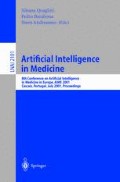Abstract
Medical information systems and standards are increasingly based on principled models of at least three distinct sorts of information — patient data, concepts (terminology), and guidelines (decision support). Well defined interfaces are required between the three types of model to allow development to proceed independently. Two of the major issues to be dealt with in the defining of such interfaces are the interaction between ontological and inferential abstractions — how general notions such as ‘abnormal cardiovascular finding’ are abstracted from concrete data- and the management of the meaning of information in guidelines in different contexts. This paper explores these two issues and their ramifications.
Access this chapter
Tax calculation will be finalised at checkout
Purchases are for personal use only
Preview
Unable to display preview. Download preview PDF.
References
Rector, A.L. The Interface between Information, Terminology, and Inference Models. in Medinfo-2001 (2001) (in press).
Tu, S.W. and M.A. Musen. Modeling data and knowledge in the EON guideline architecture. in Medinfo 2001 (2001) (in press).
HL7, HL7 Data Model Development, (2000), http://www.hl7.org/library/data-model/
CEN/WG1, ENV13606: Electronic Healthcare Record Architecture,. 1999, CEN.
Ingram, D., GEHR: The Good European Health Record, in Health in the New Communications Age, M. Laires, M. Ladeira, and J. Christensen, Editors. IOS Press: Amsterdam. (1995) 66–74.
Education, C.f.H.I.a.M., The GEHR Homepage, (1997), http://www.cww.chime.ucl.ac.uk/HealthI/GEHR/
Spackman, K.A., K.E. Campbell, and R.A. Côté, SNOMED-RT: A reference Terminology for Health Care. Journal of the American Medical Informatics Association (JAMIA), ((Symposium special issue)): (1997) 640–644.
OpenGALEN, OpenGALEN Home Page, http://www.opengalen.org
Rector, A., Thesauri and formal classifications: Terminologies for people and machines. Methods of Information in Medicine, 37(4-5): (1998) 501–509.
Pryor, T. and G. Hripscsak, The Arden syntax for medical logic modules. Int J Clin Monit Comput,. 10(4): (1993) 214–224.
Tu, S.W. and M.A. Musen. A flexible approach to guideline modelling. in AMIA Fall Symposium. Hanley and Belfus (1999) 420–424.
Johnson, P.D., et al., Using scenarios in chronic disease management guidelines for primary care. JAMIA, (Symposium Special Issue): (2000) 389–393.
Fox, J. and S. Das, Safe and Sound., Cambridge MA: MIT Press. (2000).
Peleg, M., et al. GLIF3: The evolution of a guideline representation format. in AMIA Fall Symposium (2000) 645–649.
Shahr, Y. Timing is everything: temporal reasoning and temporal data maintenance in medicine. in Seventh Joint European Conference on Artificial Intelligence in Medicine and Medical Decision Making. Springer Verlag (1999)
Berg, M., Medical work and the computer-based patient record: A sociological perspective. Methods of Information in Medicine, 37: (1998) 294–301.
Bray, J., et al., Identifying patients with ischaemic heart disease in general practice: cross sectional study of paper and computerised medical records. British Medical Journal, 321: (2000) 548–050.
Hripscak, G., et al. The Arden Syntax for Medical Logic Modules. in Fourteenth Annual Symposium on Computer Applications in Medical Care (SCAMC-90). McGraw Hill (1990)
HL7, HL7 Home Page, http://www.hl7.org
Solomon, W., et al., Having our cake and eating it too: How the GALEN Intermediate Representation reconciles internal complexity with users’ requirements for appropriateness and simplicity. Journal of the American Medical Informatics Association, (Fall Symposium Special Issue): (2000) 819–823.
College of American Pathologists, SNOMED Home Page, http://www.snomed.org
Nowlan, W.A., Clinical workstation: Identifying clinical requirements and understanding clinical information. International Journal of Bio-Medical Computing,. 34: (1994) 85–94.
Franconi, E. A Semantic approach for schema evolution and versioning in object-oriented databases. in 6th International Conference on Rules and Objects in Databases (DOOD’2000) (2000)
The OIL Home Page, (2000), http://www.ontoknowledge.org/oil/
Author information
Authors and Affiliations
Editor information
Editors and Affiliations
Rights and permissions
Copyright information
© 2001 Springer-Verlag Berlin Heidelberg
About this paper
Cite this paper
Rector, A.L., Johnson, P.D., Tu, S., Wroe, C., Rogers, J. (2001). Interface of Inference Models with Concept and Medical Record Models. In: Quaglini, S., Barahona, P., Andreassen, S. (eds) Artificial Intelligence in Medicine. AIME 2001. Lecture Notes in Computer Science(), vol 2101. Springer, Berlin, Heidelberg. https://doi.org/10.1007/3-540-48229-6_43
Download citation
DOI: https://doi.org/10.1007/3-540-48229-6_43
Published:
Publisher Name: Springer, Berlin, Heidelberg
Print ISBN: 978-3-540-42294-5
Online ISBN: 978-3-540-48229-1
eBook Packages: Springer Book Archive

